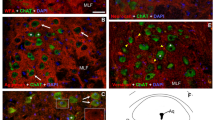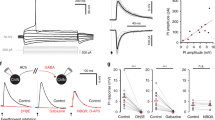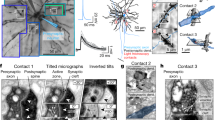Abstract
The formation of specific synaptic connections is a central part of development in the nervous system. The parasympathetic ciliary ganglion of the chick is a useful population of neurones for studying synaptogenesis both because its development has been well characterized in vivo1 and because its neurones can be maintained and examined in long-term dissociated cell culture2,3. The ciliary ganglion contains two classes of neurones: choroid neurones that innervate smooth muscle in the choroid layer of the eye, and ciliary neurones that innervate striated muscle in the iris and ciliary body. Both classes of neurone are cholinergic and both receive excitatory cholinergic input from preganglionic neurones in the accessory oculomotor nucleus. Ciliary ganglion neurones do not seem to innervate each other in vivo4,5, even though they have matching neurotransmitter and receptor types. In cell culture, the neurones acquire high levels of choline acetyltransferase activity, form cholinergic synapses on skeletal myotubes when present in the cultures, and have significant levels of acetylcholine (ACh) sensitivity2,6, as they do in vivo. We report here that cholinergic synaptic transmission does occur between the neurones in cell culture. These results indicate that ciliary ganglion neurones can innervate each other, and suggest that additional constraints exist in vivo to prevent them from doing so.
This is a preview of subscription content, access via your institution
Access options
Subscribe to this journal
Receive 51 print issues and online access
$199.00 per year
only $3.90 per issue
Buy this article
- Purchase on Springer Link
- Instant access to full article PDF
Prices may be subject to local taxes which are calculated during checkout
Similar content being viewed by others
References
Landmesser, L. & Pilar, G. J. Physiol., Lond. 222, 691–713 (1972); J. Physiol., Lond. 241, 737–749 (1974); J. Cell Biol. 68, 357–374 (1976); Fedn Proc. 37, 2016–2022 (1978).
Nishi, R. & Berg, D. K. Proc. natn. Acad. Sci. U.S.A. 74, 5171–5175 (1977); Nature 277, 232–234 (1979); J. Neurosci. 1, 505–513 (1981).
Tuttle, J. B., Suszkiw, J. B. & Ard, M. Brain Res. 183, 161–180 (1980).
Marwitt, R., Pilar, G. & Weakly, J. N. Brain Res. 25, 317–334 (1971).
Giacobini, E., Pilar, G., Suszkiw, J. & Uchimura, H. J. Physiol., Lond. 286, 233–253 (1979).
Ravdin, P. M. & Berg, D. K. Proc. natn. Acad. Sci. U.S.A. 76, 2072–2076 (1979).
Ravdin, P. M., Nitkin, R. M. & Berg, D. K. J. Neurosci. 1, 849–861 (1981).
O'Lague, P. H., Obata, K., Claude, P., Furshpan, E. J. & Potter, D. D. Proc. natn. Acad. Sci. U.S.A. 71, 3602–3606 (1974).
Furshpan, E. J., MacLeish, P. R., O'Lague, P. H. & Potter, D. D. Proc. natn. Acad. Sci. U.S.A. 73, 4225–4229 (1976).
Pilar, G. & Tuttle, J. Soc. Neurosci. Abstr. 4, 593 (1978).
Sargent, P. B. & Dennis, M. J. Devl Biol. 81, 65–73 (1981).
Author information
Authors and Affiliations
Rights and permissions
About this article
Cite this article
Margiotta, J., Berg, D. Functional synapses are established between ciliary ganglion neurones in dissociated cell culture. Nature 296, 152–154 (1982). https://doi.org/10.1038/296152a0
Received:
Accepted:
Issue Date:
DOI: https://doi.org/10.1038/296152a0
This article is cited by
-
Coated vesicles are associated with acetylcholine receptors at nerve-muscle contacts
Journal of Neurocytology (1984)
-
Kinetics of acetylcholine activated ion channels in chick ciliary ganglion neurones grown in tissue culture
Pfl�gers Archiv European Journal of Physiology (1984)
Comments
By submitting a comment you agree to abide by our Terms and Community Guidelines. If you find something abusive or that does not comply with our terms or guidelines please flag it as inappropriate.



